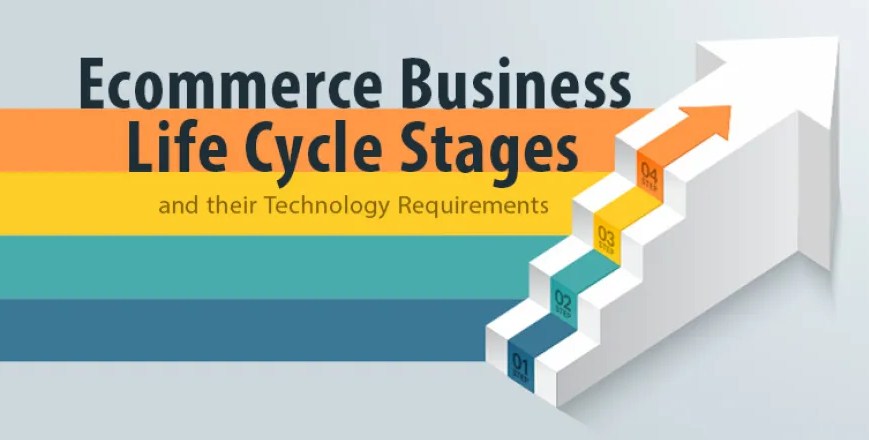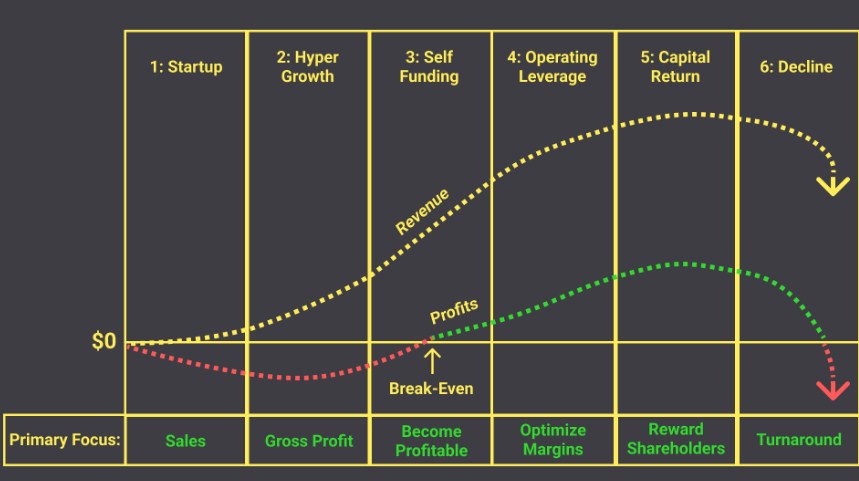Business Life Cycle Stages in Order – The journey of any business is characterized by a series of stages that reflect its growth, development, and challenges. The business life cycle stages in order outline the process a business undergoes from inception to eventual maturity and beyond. Understanding these stages can help entrepreneurs, managers, and investors make informed decisions, plan strategies, and effectively navigate the ups and downs of business.

In this article, we’ll break down the business life cycle stages, explain their importance, provide product recommendations, and discuss how to buy tools to optimize each stage of your business.
Business Life Cycle Stages: A Breakdown
The business life cycle typically consists of five key stages:
- Seed and Development Stage
- Startup Stage
- Growth Stage
- Maturity Stage
- Decline/Exit Stage
Let’s explore each stage in detail to understand its relevance and how businesses can thrive at each phase.
1. Seed and Development Stage
At the Seed and Development stage, the business idea is born. Entrepreneurs validate their ideas, develop a business plan, and seek initial funding. This stage focuses on research, planning, and minimal product development. It’s also when most startups struggle to establish their footing.
Key Points:
- Focus on product-market fit
- Secure initial funding or investment
- Conduct market research and feasibility studies
2. Startup Stage
During the Startup stage, businesses begin to operate with their initial products or services. Revenue generation is often low, and costs can be high. At this stage, businesses must build a customer base, refine their offering, and begin scaling operations.
Key Points:
- Branding and marketing become critical
- Business operations begin
- Risk management and resource allocation are vital
3. Growth Stage
The Growth stage is where the business starts seeing significant returns. As sales increase and the customer base grows, businesses may need to scale operations, hire more employees, and diversify offerings. This is where strategic planning and efficient resource management play a critical role in sustaining the business’s upward trajectory.
Key Points:
- Focus on customer retention
- Expanding market share
- Scaling operations and processes
4. Maturity Stage
In the Maturity stage, the business has reached its peak and stabilized. Revenue growth begins to slow, but the business remains profitable. This stage is about maintaining competitive advantage, optimizing operations, and ensuring brand loyalty.
Key Points:
- Innovation to stay competitive
- Risk of market saturation
- Efficiency in operations
5. Decline/Exit Stage
The Decline or Exit stage is marked by decreasing sales, market share, and profitability. It can also be a point of strategic exit, where business owners sell or shut down the business. Recognizing when to exit or pivot is crucial for minimizing losses.
Key Points:
- New product development or market shifts
- Divestment strategies or mergers
- Managing a strategic exit
Benefits of Understanding Business Life Cycle Stages

Knowing these stages provides valuable insights for managing and growing your business:
- Strategic Planning: Understanding what stage your business is in allows you to implement the right strategies for growth, investment, and risk management.
- Efficient Resource Allocation: Knowing when to invest in technology, staff, and marketing helps avoid wasteful spending.
- Improved Decision-Making: By recognizing the signs of each stage, business owners can make informed decisions that ensure long-term success.
- Sustained Growth: With the right strategies and tools, businesses can maximize growth and profitability during key stages, especially during the growth and maturity phases.
Essential Products to Help Navigate Each Stage
In each stage of the business life cycle, various products and tools can help streamline operations, enhance productivity, and improve decision-making. Below are five real-world examples of tools and products that entrepreneurs can leverage to navigate each stage of the business life cycle.
1. Trello for Project Management
Trello is a powerful tool for organizing tasks, managing workflows, and coordinating teams. During the startup and growth stages, staying organized is essential.
Use Case:
- Track project progress
- Collaborate with team members
- Visualize business workflows
Pros:
- Easy to use
- Flexible board system
- Real-time updates
Cons:
- Limited features in free version
- Can become overwhelming for large teams
Price:
- Free version available
- Paid plans start at $10 per user/month
| Features | Pros | Cons | Price |
|---|---|---|---|
| Task Management | Visual boards, flexible | Limited free features | Free/Pro |
2. QuickBooks for Financial Management
QuickBooks is one of the most popular accounting software platforms, ideal for managing finances, payroll, and taxes.
Use Case:
- Track income and expenses
- Automate payroll processing
- Generate financial reports
Pros:
- Automated bookkeeping
- Customizable reports
- Scalable for small businesses
Cons:
- Can be expensive for small businesses
- Learning curve for beginners
Price:
- Starts at $25 per month
| Features | Pros | Cons | Price |
|---|---|---|---|
| Financial Management | Automated, scalable | Expensive for small businesses | Starts at $25/month |
3. HubSpot CRM for Customer Management
HubSpot offers a comprehensive CRM system for managing customer relationships, essential during the growth stage.
Use Case:
- Track customer interactions
- Manage sales pipeline
- Automate email marketing
Pros:
- Free version available
- Easy-to-use interface
- Powerful automation features
Cons:
- Limited features in free version
- Can get pricey for advanced features
Price:
- Free version available
- Paid plans start at $50/month
| Features | Pros | Cons | Price |
|---|---|---|---|
| Customer Management | Free, automation | Limited in free plan | Starts at $50/month |
4. Canva for Marketing and Branding
Canva is an excellent tool for creating marketing materials such as flyers, social media posts, and business cards, especially useful in the startup stage when branding is key.
Use Case:
- Create professional marketing assets
- Build brand identity
- Design social media posts
Pros:
- User-friendly design tools
- Free version available
- Templates for quick creation
Cons:
- Limited design elements in free plan
- Advanced design options are locked behind a paywall
Price:
- Free version available
- Paid plans start at $12.99/month
| Features | Pros | Cons | Price |
|---|---|---|---|
| Design and Branding | User-friendly | Limited templates | Free/Pro |
5. Shopify for E-Commerce
Shopify is an e-commerce platform that helps businesses sell products online, especially during the growth and maturity stages.
Use Case:
- Set up an online store
- Manage product listings and payments
- Integrate with marketing tools
Pros:
- Easy-to-use interface
- Scalable for businesses of all sizes
- Integrates with other tools like Mailchimp
Cons:
- Transaction fees for basic plans
- Limited customization in cheaper plans
Price:
- Plans start at $29/month
| Features | Pros | Cons | Price |
|---|---|---|---|
| E-Commerce | Easy setup, scalable | Transaction fees | Starts at $29/month |
Where to Buy These Tools and Products
Each of these tools can be purchased online through their official websites. You can sign up for free trials to test them out before committing to a subscription plan. Below are some quick links to each product:
- Trello
- QuickBooks
- HubSpot
- Canva
- Shopify
5 FAQs About Business Life Cycle Stages
- What is the most challenging stage in the business life cycle?
- The Startup stage is often considered the most challenging due to limited resources and the uncertainty of market response.
- How do I know which stage my business is in?
- Evaluate your revenue, customer base, and growth trends. If you’re still refining your product, you’re likely in the startup phase. If you’re scaling rapidly, you’re in the growth stage.
- Can my business skip a stage in the life cycle?
- No, all businesses go through these stages, but some may progress faster than others depending on market conditions and business strategies.
- How do I prepare for the decline stage?
- Businesses can pivot, innovate, or sell before they reach the decline phase. Regularly assessing your market and customer needs can help avoid this.
- What products can help me succeed in the growth stage?
- Tools like QuickBooks, HubSpot, and Shopify can assist with financial management, customer relationships, and e-commerce during the growth phase.
By understanding and navigating the business life cycle stages in order, entrepreneurs can better manage their business’s growth, optimize resources, and improve their chances of long-term success. Invest in the right tools to help you at each stage and watch your business flourish!
Read More >>>
- Understanding the 7 Stages of the Business Life Cycle: A Complete Guide for Entrepreneurs
- Big Data Architectures: Benefits, Use Cases, and Top Products to Enhance Your Data Strategy